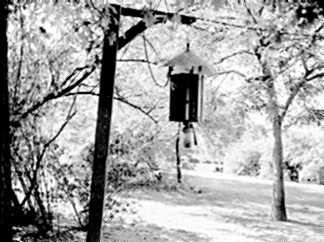Reproduced from the New Jersey Agricultural Experiment Station, Rutgers University. Please use the following citation when referring to this article:
Mulhern, T. D. 1942 New Jersey mechanical trap for mosquito surveys. New Jersey Experiment Station Circular Number 421 (March).
THOMAS MULHERN, Associate in Mosquito Control, Rutgers University, New Brunswick, NJ



There are wide differences in the breeding habits of individual species of mosquitoes. These habits are so well understood that a knowledge of the mosquitoes present in a given area indicates to the trained mosquito control workers what type of breeding place to search for. With this information at hand, the drainage, spraying, and other measures necessary for mosquito control can be directed against the different species in the order of their economic importance. By attacking first the species which are most prevalent, the greatest possible reduction in the mosquito pest can be obtained with the funds expended.
Methods of collecting by hand both larval and adult mosquitoes were devised, and information of much value has been secured by inspectors utilizing hand collections; in fact.. such collections are still a source of important data. There are, however, certain limitations to the use of hand methods of collecting adult mosquitoes: some inspectors have greater manual dexterity and therefore catch more mosquitoes than others; some persons are not bitten by mosquitoes and these are of no value as collectors; some species of mosquitoes are more wary than others and are likely to escape capture; and inspectors may not be collecting when mosquitoes are most active, for it is not feasible to make hand collections continuously all night; and the cost of hand collections, together with the lack of a sufficient number of trained men, makes it impracticable to make nightly collections throughout the mosquito breeding season from a large number of stations.
For these and other reasons it was evident that mechanical means of continuously collecting samples of the mosquitoes should be developed. Accordingly, in 1927, development of a trap to replace the human collector was begun. The first trap depended upon light alone as an -attractant and catching medium, but its catching power was not sufficient to meet the need. In 1930 the first trap was constructed which employed a light bulb to attract the mosquitoes and an electric fan to draw them in. The traps were operated near houses where electric current was available. The light bulb and fan were placed in a horizontal tube which was set up facing the direction from which the wind was blowing. The insects were received in a net bag placed over the end of the tube. Enough mosquitoes were caught so the unit could be used to replace human collectors. A number of mechanical improvements were made, but the trap was still considered not entirely satisfactory. In 1932 the trap was completely redesigned, and converted from horizontal to vertical operation. It was designated Model 50, and seemed to meet all requirements. In 1933 it was adopted as the standard type for use in New Jersey, and has been in service every summer since. Few changes have been made in the trap stations originally selected. and the data taken not only allows comparisons to be made of the mosquito population in various parts of the state, within any one of the years of operation, but comparisons of the mosquito population from year to year at the same station may be made. From the middle of June to the middle of September about 40 traps are operated by the State Agricultural Experiment Station, and about the same number are operated by the county mosquito extermination commissions. The data taken is of very great value, for it indicates what species of mosquitoes are present and causing annoyance, and work against the particular species can then be intensified. At the same time the effectiveness of the present control work is measured. These are the most important uses of traps. They have been used also in searching for breeding places that were not found by the usual methods, and in measuring the flight of broods of mosquitoes.
Description
The Model 50 trap consists of a vertical tube of 22 gauge galvanized iron, 9 inches inside diameter, and 12 inches long. Above the tube is a conical roof, 16 inches in diameter, also of galvanized iron, to keep out rain. The lower surface of the roof is painted white as a reflector for the light which serves as the attractant to draw the mosquitoes into the immediate vicinity of the trap. The light used is a 25-watt, 110-volt, white, frosted inside, bulb. Over the upper end, or mouth, of the tube is a 5/16-inch mesh screen to keep out large moths or other insects, while permitting the mosquitoes and small insects to enter. just below the screen is a fan, having a capacity of 360 to 400 cubic feet of air per minute, with the air blast directed downward. Below the fan is a funnel-shaped screen of 16-mesh bronze wire. The large end of this screen fits snugly inside the tube, just below the blades of the fan, and the small or apex end extends slightly below the bottom end of the tube and terminates in a mason jar cap. A pint jar. containing a layer of calcium cyanide crystals about one-half inch thick, which is held in place by alternate layers of cotton and cardboard. is screwed to the cap and serves as a killing chamber for the insects. To simplify removal of the catch a waxed paper cup just large enough to fit tightly is placed in the mouth of the jar and the insects drop into this cup, where they are promptly killed by the gas from the cyanide, which enters through small holes punched in the sides of the paper cup for that purpose. Three legs bolted to the tube extend below it for feet and above it as a support for the roof and the electric light bulb. The bulb is attached through a block of sponge rubber which absorbs vibration from the fail and thereby reduces breakage of the lamp filaments. The exterior of the trap is usually painted green to harmonize with vegetation in the yard where it may be placed. In use it is set up on a 2-inch by 4-inch wood post, which is bolted to one side of the tube. The height of the trap measured from the edge or eaves of the roof should be 5 feet, 6 inches from the ground, and the post extends 18 inches into the ground. All fastenings should be made with brass screws and nuts to avoid rusting and consequent loss of time when servicing the trap.

(In use it is fastened to a 2" x 4" wooden post by means of two 1/4" bolts. Upper bolt is reached by lifting screen from mouth of trap. Lower one can be reached from below.)
- Galvanized iron tube, 22 ga., 9" I.D. (Cut away to show interior).
- Roof of galvanized iron, 22 ga., to exclude rain and serve as a reflector.
- Motor and 8" dia. fan. Air capacity 360 to 400 cu. ft. per min. Induction type motor. Do not use motor with brushes. or radio reception near the trap may be interfered with.
- Porcelain receptacle. Use 25-watt bulb.
- Sponge rubber to absorb vibration.
- 3 ribs of 1/8" x 1" band iron, equally spaced about tube, extended below tube to serve as legs and above to support roof. One extended to support light receptacle. The legs support the trap during transportation and servicing. As may be seen from the cover photograph. they are not used for hanging the trap. In the drawing, the legs are revolved out of position and only two are shown.
- Assemble with 8 x 3/8" brass machine screws and nut.-.
- Interior screen of 16 mesh bronze wire. Bands of 22 ga. galv. iron 1" wide at top and 1/2" wide near jar cap. 3 ribs of same material equally spaced about screen and extended to hook over upper end of tube. Screen soldered securely to upper band, ribs, and jar cap. Entire unit to fit snugly inside tube, but to be readily removable for cleaning.
- Zinc mason jar cap.
- 3/8" mesh galvanized screen over mouth of tube to prevent entry of large insects while permitting entry of mosquitoes and other small insects.
- Loop over roof is used for carrying or for hanging trap.
The mosquitoes are attracted by the light, and when they fly close they are caught by the suction of the fan, drawn into the opening between the upper end of the tube and the roof, and swept down through the fan blades, along the funnel shaped screen, and into the jar filled with lethal gas.
An automatic time switch is usually provided to start and stop the trap at predetermined times. In New Jersey 7:00 P. M. to 7:00 A.M.. has been adopted as the standard operating period. Any of the available commercially made switches having a load capacity of 5 amperes or more can be used, and the type with self-starting electric motor is preferred. In service, the switch is usually placed at the source of current, in a cellar, on a porch, or in some other place where it will be protected from the weather.
Location
Great care should be taken in selecting the places where traps are to be operated in connection with a general survey if the data taken are to be comparable. Spectacular catches may result if traps are placed in an area influenced by a source of great attraction to mosquitoes, and few mosquitoes may be taken where the trap is located within the influence of a force serving as a repellent or as a counter attractant. Also, if a trap is operated where it has no competition at all from other forces attractive to mosquitoes, it may take large catches, whereas if it be located in the midst of a number of sources of attraction its own power may be overshadowed and low catches will result. A number of examples of this type have occurred, and wherever catches appear to be unusual, an investigation should be made to determine whether some outside force is interfering with the accurate operation of the trap. Since the aim is to measure the average annoyance suffered by the population of. the area concerned, traps should be set in average residential areas. A good location might be -found in the back yard of a home on a quiet street, several blocks from the business center of the town and a reasonable distance away from the open country surrounding the town. There should be shrubbery around the trap, which should be 10 to 50 feet from a house. An inspection should be made to be certain that there is no rain barrel, cesspool, or other breeding places producing mosquitoes closer than a hundred feet from the trap. Some of the places to be avoided are industrial plants giving off large amounts of smoke, gases, or odors; locations open to prevailing strong winds, such as along the beach near the seashore: buildings in which animals are stabled; and any place where there is throughout the night a high level of artificial light, as at airports and pumping stations.
Method of Operation
Suitable locations can generally be found at the residences of public-spirited citizens who can be prevailed upon to co-operate by allowing the trap to be connected to their household electric service and by emptying it each morning. The cost of current consumed each 12 hours of operation is approximately 6 cents (At the usual New Jersey rate of 7 cents per kilowatt hour) so the co-operators are paid $1.80 per month. Sometimes very good locations can be established at municipal buildings, police stations, firehouses, etc. The ideal method of handling collections is to have them brought into the laboratory immediately after the trap is shut off in the morning, and identified at once so the executive in charge of the control work can have records of any unusual flight or emergence of mosquitoes and can place in effect emergency measures. This is the system being used by several county mosquito extermination commissions in the operation of their own traps. Where a survey involves a large area and many traps, speed in handling the material must be sacrificed if the costs are to be kept to a minimum.
The New Jersey Agricultural Experiment Station operates 40 traps throughout the state, and it has been found satisfactory and economical to make the collections as follows: Each night's insects are placed by the co-operator in one of eight special boxes packed in a carton on which the name of the station has been written by the trap service man. The co-operator marks on the box the date the collection was removed. At the end of a week of operation the service man calls for the collection, tests the trap and time switch and makes any needed adjustments. The insects are brought to the laboratory and there the female mosquitoes are separated from the other insect material, counted, identified as to species, and recorded on special forms, copies of which are sent to the mosquito commissions likely to be benefited by the information. The entire time of two summer employees is required in the operation of the traps, and approximately 3,500 miles of auto travel is necessary each month.
Suggestions for Trap Service
The trap service man holds a key position in the survey, for he alone has an opportunity to detect immediately any irregularities of operation, and his careful attention to detail will result in complete records and accurate data. He should therefore develope a routine and follow it carefully.
- Arrange a travel schedule so the co-operator may know when to expect his visit.
- Upon arrival at a station, inquire of the co-operator if there is any special information concerning operation during the preceding week.
- Be sure there are insects in each box and proper dates and station names marked thereon. If collection is incomplete, try to find out why
- Leave carton of boxes for following week. Be sure name of station is on carton.
- Check automatic switch for timing, turn on trap, be sure light is not burned out, and that fan starts quickly and runs freely and without excessive vibration. Clean and lubricate fan motor every, four weeks, or oftener if it appears to be operating slowly.
- Clean screen if it is clogged with large insects, dust, spider webs, or other obstructions. Make any other adjustments necessary.
- Replace cyanide in killing jar every three weeks, or oftener if any live insects are found incollection boxes. Be sure killing jar bears a label marked "POISON".
- Reset time switch.
- Make complete notes concerning any unusual circumstances or conditions so the information will be available to the laboratory man when the collection is being identified. Include for checking purposes a list of the dates for which collections are included.

Form is mimeographed on 81/2" x 11" paper. Columns are wide for normally predominating species. Wide space for every fifth day aids in following lines and placing figures in proper location. A key to miscellaneous species. more or less rarely taken, is provided on the back of the form, as follows: A-P. columbiae, B- P. ciliate, C- P. posticata, D- P. discolor, E- C.melanurus, F- C. atropalpus, G-,An barberi, H-A. hirsuteron, I-A. aurifer, J-A. grossbecki, K-A. nivei. tarsis, L- A. fuscus, M- A. dupreii, N- A. abfitchii, 0- A. cinereus, P- A. atlanticus, Q-IV.,smithii.
Interpretation
There are several factors in addition to location that may considerately affect the catching rate of a trip. In general, any cause of greater activity of the mosquito is apt to result in increased catches. Hence high temperature are likely to mean large catches, but few mosquitoes are taken below temperatures of 60 degrees F., when there is little mosquito activity. High humidity generally promotes large catches, but during heavy rains or high winds the mosquitoes seek shelter and few are caught. Where daylight biting forms of mosquitoes are present considerable annoyance may result even though the trap indicates there are few mosquitoes about. This condition arises when day and early evening are warm enough to encourage mosquito movement, but temperatures at night when the traps are operating are low enough to inhibit flight. It is desirable that nightly catches be coordinated with complete information concerning weather.
Under conditions prevailing in New Jersey a catch of 24 or more female mosquitoes will generally result if mosquitoes are sufficiently, numerous to cause the householders in the neighborhood to complain of annoyance, However, there are generally no mosquitoes, or very few, catches as low as 8 per night may produce complaints, and on the other Hand in the section, unprotected by mosquito control work but where mosquitoes are numerous throughout the summer and the populace accustomed to having them about, catches much higher than 24 may cause no reaction. The annoyance index of 24 per night must therefore be considered more or less variable with regard to individual station catches, although it has proved satisfactory for interpreting the results of general trapping over the state.
Chemical attractants, notably carbon dioxide, when used with the traps have resulted in very greatly increased catches. Fans of greater air moving capacity than the fans normally used in the trap also increase the catching power, and preliminary tests of large traps have been made by several workers and very large catches taken. Experiments with lights of various colors have indicated differences in the response of mosquitoes. Further work along these lines may result in the development of a trap that may be used as a control measure for ridding areas of limited size of mosquitoes. such as a front porch or back yard. At present, the trap should be regarded as a measurement, or survey instrument, and results of experiments with traps modified in any respect should be kept strictly separate from those taken with the standard trap.
References
- Headless, T. J. 1932. Development of mechanical equipment for sampling the mosquito fauna and some results of its use. Proc. 19th Ann. Meet. N.J. Mosq. Exterm. Assoc. P. 106
- Mulhern, T. D. 1932. A new development in mosquito traps. Proc. 21st Ann. Assoc. P. 137
- Vanderwerker, R. J. 1937. The Relation of mosquito Trap Catches to Human Comfort. Proc. 24th Ann. Meet. N.J. Mosq. Exterm. Assoc. P. 25.
- Vanderwerker, R.J. 1939. Effective and Intelligent use of the New Jersey mosquito trap for mosquito control in a local area. Proc. 26th Ann. Meet. N.J. Mosq. Exterm. Assoc. p. 199
